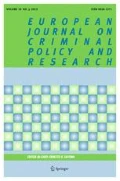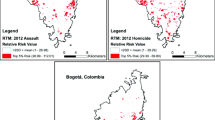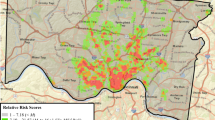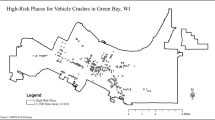Abstract
Environmental Criminology has developed a robust framework that provides the scientific support and necessary foundation for crime analysis through crime mapping. This theoretical approach focuses on the situational and temporal characteristics of criminal opportunity rather than on the offender’s behavior for crime prevention. In the scope of road safety and traffic crashes, few studies have adopted this approach. This study used risk terrain modeling (RTM), developed by the Rutgers Center on Public Security, to determine the relative importance of varying environmental risk factors on alcohol-related crashes and traffic accidents. The independent variables consisted of a set of potential environmental risk factors, while the dependent variable comprised all DWI crashes and traffic accidents in the province of Cádiz in 2012. According to the results of the current study, restaurant locations are spatially associated with the occurrence of drunk driving crashes, while proximity restaurants and recreational lodging centers correlate with the sites of traffic accidents.


Similar content being viewed by others
Notes
We used line-feature shapefiles to represent all of Cádiz’ road networks. These data were obtained from the Instituto de Estadística y Cartografía de Andalucía.
Translated from Spanish: Accidentes, Recogida de Información y Análisis (ARENA)
(9 factors * 2 operationalizations * 4 blocks * 2 “half increments” + 2 factors * 1 operationalization * 4 blocks * 2 “half increments”) = 160 variables.
The same potential risk factors were tested in both RTM models for traffic accidents and DWI crashes.
The “best model” consisted of the one with the lowest Bayesian information criterion (BIC) score.
The cell size for the analysis was 500 m, similar to RTM, and the search radius was set to 4000 m, thus assuming the maximum spatial influence used with RTM.
In the PAI formula, n is the number of crashes in the high-risk places or the hot spots, N is the total number of crashes, a is the area in square kilometers of the high-risk places or the hot spots, and A is the total area for the study.
Based on the differential relative risk score (RRS) obtained with RTM for highways (RRS = 8.19) and secondary road networks (RRS = 5.23).
As indicated by the RRS value of 1.82 obtained from the “Best Model Specifications” output produced by the RTMDx software.
References
Abdel-Aty, M. A., & Radwan, A. E. (2000). Modeling traffic accident occurrence and involvement. Accident Analysis & Prevention, 32(5), 633–642.
Affum, J. K., & Taylor, M. A. (1998). Selatm—a GIS based program for evaluating the safety benefits of local area traffic management schemes. Transportation Planning and Technology, 21(1-2), 93–119.
Anderson, T. K. (2009). Kernel density estimation and K-means clustering to profile road accident hotspots. Accident Analysis & Prevention, 41(3), 359–364.
Black, R. (1991). Refugees and displaced persons: geographical perspectives and research directions. Progress in Human Geography, 15(3), 281–298.
Brantingham, P. L., & Brantingham, P. L. (1993). Environment, routine and situation: toward a pattern theory of crime. Advances in Criminological Theory, 5(2), 259–294.
Brantingham, P., & Brantingham, P. (1995). Criminality of place. European Journal on Criminal Policy and Research, 3(3), 5–26.
Brantingham, P. J., & Tita, G. (2008). Offender mobility and crime pattern formation from first principles. In L. Liu & J. Eck (Eds.), Artificial crime analysis systems: Using computer simulations and geographic information systems (pp. 193–208). Hershey: Idea Press.
Caetano, R., & Clark, C. L. (2000). Hispanics, blacks and whites driving under the influence of alcohol: results from the 1995 national alcohol survey. Accident Analysis & Prevention, 32(1), 57–64.
Camacho-Collados, M., & Liberatore, F. (2015). A decision support system for predictive police patrolling. Decision Support Systems, 75, 25–37.
Caplan, J. M. (2011). Mapping the spatial influence of crime correlates: a comparison of operationalization schemes and implications for crime analysis and criminal justice practice. Cityscape, 13, 57–83.
Caplan, J. M., & Kennedy, L. W. (2010). Risk terrain modeling manual: Theoretical framework and technical steps of spatial risk assessment for crime analysis. Newark: Rutgers Center on Public Security.
Caplan, J. M., & Kennedy, L. W. (2016). Risk terrain modeling: Crime prediction and risk reduction. Oakland: Univ of California Press.
Caplan, J. M., Kennedy, L. W., & Miller, J. (2011). Risk terrain modeling: brokering criminological theory and GIS methods for crime forecasting. Justice Quarterly, 28(2), 360–381.
Caplan, J. M., Kennedy, L., & Piza, E. (2013). Risk terrain modeling diagnostics user manual (version 1.0). Newark: Rutgers Center on Public Security.
Chainey, S., Tompson, L., & Uhlig, S. (2008). The utility of hotspot mapping for predicting spatial patterns of crime. Security Journal, 21(1-2), 4–28.
Chang, I., Lapham, S. C., & Barton, K. J. (1996). Drinking environment and sociodemographic factors among DWI offenders. Journal of Studies on Alcohol, 57(6), 659–669.
Cohen, L., & Felson, M. (1979). Social change and crime rate trends: a routine activity approach. American Sociological Review, 44(4), 588–608.
Cornish, D. B., & Clarke, R. V. (Eds.). (1986). The reasoning criminal: Rational choice perspectives on offending. New York: Springer.
Daley, D., Bachmann, M., Bachmann, B. A., Pedigo, C., Bui, M. T., & Coffman, J. (2016). Risk terrain modeling predicts child maltreatment. Child Abuse & Neglect, 62, 29–38.
Dirección General de Tráfico. (2015). Anuario estadístico. Ministerio del Interior.
Drawve, G. (2016). A metric comparison of predictive hot spot techniques and RTM. Justice Quarterly, 33(3), 369–397.
Drawve, G., Belongie, M., & Steinman, H. (2017). The role of crime analyst and researcher partnerships: a training exercise in Green Bay, Wisconsin. Policing: A Journal of Policy and Practice, 12, 277–287.
Dugato, M. (2013). Assessing the validity of risk terrain modeling in a European city: preventing robberies in the city of Milan. Crime Mapping, 5(1), 63–89.
Dugato, M., Calderoni, F., & Berlusconi, G. (2017). Forecasting organized crime homicides: risk terrain modeling of camorra violence in Naples, Italy. Journal of Interpersonal Violence. https://doi.org/10.1177/0886260517712275.
Elvik, R. (2001). Cost-benefit analysis of police enforcement. Report ESCAPE Project. Working Paper. Helsinki: VTT.
Erdogan, S., Yilmaz, I., Baybura, T., & Gullu, M. (2008). Geographical information systems aided traffic accident analysis system case study: city of Afyonkarahisar. Accident Analysis & Prevention, 40(1), 174–181.
Erke, A., Goldenbeld, C., & Vaa, T. (2009). Good practice in the selected key areas: Speeding, drink driving and seat belt wearing. Results from meta-analysis. Police Enforcement Policy and Programmes on European Roads (PEPPER), Deliverable, 9.
Ewing, R., & Dumbaugh, E. (2009). The built environment and traffic safety: a review of empirical evidence. CPL Bibliography, 23(4), 347–367.
Famega, C. N. (2005). Variation in officer downtime: a review of the research. Policing: An International Journal of Police Strategies & Management, 28(3), 388–414.
Fell, J. C., Waehrer, G., Voas, R. B., Auld-Owens, A., Carr, K., & Pell, K. (2014). Effects of enforcement intensity on alcohol impaired driving crashes. Accident Analysis & Prevention, 73, 181–186.
Fundación Ideas para la Paz. (2015). Atlas Microtráfico y Comercialización de Sustancias Psicoativas en Pequeñas Cantidades.
Gerell, M. (2018). Bus stops and violence, are risky places really risky? European Journal on Criminal Policy and Research, 1–21.
Giménez-Santana, A., Caplan, J. M., & Drawve, G. (2018). Risk terrain modeling and socio-economic stratification: identifying risky places for violent crime victimization in Bogotá, Colombia. European Journal on Criminal Policy and Research, 1–15.
Gruenewald, P. J., & Johnson, F. W. (2010). Drinking, driving, and crashing: a traffic-flow model of alcohol-related motor vehicle accidents. Journal of Studies on Alcohol and Drugs, 71(2), 237–248.
Harirforoush, H., & Bellalite, L. (2016). A new integrated GIS-based analysis to detect hotspots: a case study of the city of Sherbrooke. Accident Analysis and Prevention.
Instituto de Estadística y Cartografía de Analucía. (2015). Microdatos. Retrieved from: https://www.juntadeandalucia.es/institutodeestadisticaycartografia.
Kennedy, L. W., & Caplan, J. M. (2012). A theory of risky places. Research brief. Newark: Rutgers Center on Public Security.
Kennedy, L. W., & Van Brunschot, E. G. (2009). The risk in crime. Lanham: Rowman & Littlefield.
Kennedy, L. W., Caplan, J. M., Piza, E. L., & Buccine-Schraeder, H. (2015). Vulnerability and exposure to crime: applying risk terrain modeling to the study of assault in Chicago. Applied Spatial Analysis and Policy, 1–20.
Lang, E., & Stockwell, T. (1991). Drinking locations of drink-drivers: a comparative analysis of accident and nonaccident cases. Accident Analysis & Prevention, 23(6), 573–584.
Levine, N. (2017). The location of late night bars and alcohol-related crashes in Houston, Texas. Accident Analysis & Prevention, 107, 152–163.
Livingston, M., Chikritzhs, T., & Room, R. (2007). Changing the density of alcohol outlets to reduce alcohol-related problems. Drug and Alcohol Review, 26(5), 557–566.
Lucy, W. H. (2003). Mortality risk associated with leaving home: recognizing the relevance of the built environment. American Journal of Public Health, 93(9), 1564–1569.
Mammadrahimli, A. (2015). Assessment of crash location improvements in map-based geocoding systems and subsequent benefits to geospatial crash analysis. Doctoral dissertation, Clemson University.
Martin, J. L. (2002). Relationship between crash rate and hourly traffic flow on interurban motorways. Accident Analysis & Prevention, 34(5), 619–629.
Medina-Sarmiento, J. E. (2014). Felson, Marcus. In J. M. Miller (Ed.), The encyclopedia of theoretical criminology (Vol. 1). Chichester: Wiley.
Medina-Sarmiento, J. E. (2015). Actividades cotidianas y seguridad vial. Una evaluación del «guardián capaz» en la prevención de la conducción influenciada por bebidas alcohólicas. In F. Miró Llinares, A. Sanllehí, R. José, J. E. Medina Sarmiento, & L. Summers (Eds.), Crimen, oportunidad y vida diaria. Libro homenaje al Profesor Dr. Marcus Felson. Librería-Editorial Dykinson.
Miró, F., & Bautista, R. (2013). ¿Por qué cumplimos las normas penales? Sobre la disuasión en materia de seguridad vial. InDret, (4).
Miró-Llinares, F., & Medina-Sarmiento, J. E. (2015). Sobre la evolución y el impacto en el pensamiento criminológico de Marcus Felson y la Teoría de las Actividades Cotidianas. In F. Miró Llinares, A. Sanllehí, R. José, J. E. Medina Sarmiento, & L. Summers (Eds.), Crimen, oportunidad y vida diaria. Libro homenaje al Profesor Dr. Marcus Felson. Librería-Editorial Dykinson.
Moeinaddini, M., Asadi-Shekari, Z., & Shah, M. Z. (2014). The relationship between urban street networks and the number of transport fatalities at the city level. Safety Science, 62, 114–120.
Moreto, W., & Caplan, J. M. (2010). Forecasting global maritime piracy utilizing the risk terrain modeling (rtm) approach. Newark: Rutgers center on public security brief.
Morrison, L., Begg, D. J., & Langley, J. D. (2002). Personal and situational influences on drink driving and sober driving among a cohort of young adults. Injury Prevention, 8(2), 111–115.
Morrison, C., Ponicki, W. R., Gruenewald, P. J., Wiebe, D. J., & Smith, K. (2016). Spatial relationships between alcohol-related road crashes and retail alcohol availability. Drug and Alcohol Dependence, 162, 241–244.
Mustaine, E. E., & Tewksbury, R. (1999). Assessing the likelihood of drunk driving: gender, context and lifestyle. Journal of Crime and Justice, 22(1), 57–93.
National Highway Traffic Safety Administration. (2014). Data-driven approaches to crime and traffic safety (DDACTS). Operational Guidelines.
O’Donnell, M. A. (1985). Research on drinking locations of alcohol-impaired drivers: implications for prevention policies. Journal of Public Health Policy, 6(4), 510–525.
Ohyama, T., & Amemiya, M. (2018). Applying crime prediction techniques to Japan: a comparison between risk terrain modeling and other methods. European Journal on Criminal Policy and Research, 1–19.
Openshaw, S. (1984). The modifiable areal unit problem. In Concepts and techniques in modern geography 38. Norwich: Geo Books.
Peltzer, K. (2011). Road use behavior in sub-Saharan Africa. In B. Porter (Ed.), Handbook of traffic psychology (pp. 503–518). Amsterdam: Elsevier
Piza, E., Feng, S., Kennedy, L., & Caplan, J. (2017). Place-based correlates of motor vehicle theft and recovery: measuring spatial influence across neighbourhood context. Urban Studies, 54(13), 2998–3021.
Ponicki, W. R., Gruenewald, P. J., & Remer, L. G. (2013). Spatial panel analyses of alcohol outlets and motor vehicle crashes in California: 1999-2008. Accident Analysis & Prevention, 55, 135–143.
Prasannakumar, V., Vijith, H., Charutha, R., & Geetha, N. (2011). Spatio-temporal clustering of road accidents: GIS based analysis and assessment. Procedia-Social and Behavioral Sciences, 21, 317–325.
Qin, X., Ivan, J. N., & Ravishanker, N. (2004). Selecting exposure measures in crash rate prediction for two-lane highway segments. Accident Analysis & Prevention, 36(2), 183–191.
Ratcliffe, J. H. (2016). Intelligence-led policing. Abingdon: Routledge.
Sabel, C. E., Kingham, S., Nicholson, A., & Bartie, P. (2005). Road traffic accident simulation modelling-a kernel estimation approach. In The 17th annual colloquium of the spatial information research Centre University of Otago, Dunedin, New Zealand (pp. 67–75).
Sánchez Ferreira, E. (2012). Hacia un análisis sociológico de la siniestrabilidad vial. Aposta. Revista de Ciencias Sociales, 52, 6–18.
Sherman, L. W., Gartin, P. R., & Buerger, M. E. (1989). Hot spots of predatory crime: routine activities and the criminology of place. Criminology, 27(1), 27–56.
Slagle, B. A. (2014). Drinking and driving: A pilot study of subjective norms, attitudes and behaviors of German and American students. Doctoral dissertation.
Steenberghen, T., Dufays, T., Thomas, I., & Flahaut, B. (2004). Intra-urban location and clustering of road accidents using GIS: a Belgian example. International Journal of Geographical Information Science, 18(2), 169–181.
Stitt, B. G., & Giacopassi, D. J. (1992). Alcohol availability and alcohol-related crime. Criminal Justice Review, 17(2), 268–279.
Thomas, I. (1996). Spatial data aggregation: exploratory analysis of road accidents. Accident Analysis & Prevention, 28(2), 251–264.
Turrisi, R., & Jaccard, J. (1992). Cognitive and attitudinal factors in the analysis of alternatives to drunk driving. Journal of Studies on Alcohol, 53(5), 405–414.
Usdan, S. L., Moore, C. G., Schumacher, J. E., & Talbott, L. L. (2005). Drinking locations prior to impaired driving among college students: implications for prevention. Journal of American College Health, 54(2), 69–75.
Vemulapalli, S. S., Ulak, M. B., Ozguven, E. E., Sando, T., Horner, M. W., Abdelrazig, Y., & Moses, R. (2016). GIS-based spatial and temporal analysis of aging-involved accidents: a case study of three counties in Florida. Applied Spatial Analysis and Policy, 1–27.
Watts, R. K., & Rabow, J. (1983). Alcohol availability and alcohol-related problems in 213 California cities. Alcoholism: Clinical and Experimental Research, 7(1), 47–58.
Wechsler, H., Lee, J. E., Nelson, T. F., & Lee, H. (2003). Drinking and driving among college students: the influence of alcohol-control policies. American Journal of Preventive Medicine, 25(3), 212–218.
Wegman, F., Commandeur, J., Doveh, E., Eksler, V., Gitelman, V., Hakkert, S., & Oppe, S. (2008). SUNflowerNext: towards a composite road safety performance index. Deliverable, D6, 16.
Weisburd, D. (2015). The law of crime concentration and the criminology of place. Criminology, 53(2), 133–157.
Weisburd, D., & Lum, C. (2005). The diffusion of computerized crime mapping in policing: linking research and practice. Police Practice and Research, 6(5), 419–434.
Weiss, M. W. (2016). Traffic enforcement, policing, and crime rates.
WHO. (2015). Global status report on road safety 2015. World Health Organization.
Funding
The current study was part of the I + D + i project entitled “(MapVial) Environmental Criminology, police intervention and decision making for the prevention of under the influence driving and car accidents. Analysis of a province”, with reference SPIP2015-01691, funded by the Dirección General de Tráfico (DGT).
Author information
Authors and Affiliations
Corresponding author
Rights and permissions
About this article
Cite this article
Giménez-Santana, A., Medina-Sarmiento, J.E. & Miró-Llinares, F. Risk terrain modeling for road safety: identifying crash-related environmental factors in the province of Cádiz, Spain. Eur J Crim Policy Res 24, 451–467 (2018). https://doi.org/10.1007/s10610-018-9398-x
Published:
Issue Date:
DOI: https://doi.org/10.1007/s10610-018-9398-x




